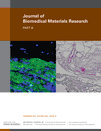Mechanical evaluation and cell response of woven polyetheretherketone scaffolds†
How to cite this article: Edwards SL, Werkmeister JA. 2012. Mechanical evaluation and cell response of woven polyetheretherketone scaffolds. J Biomed Mater Res Part A 2012:100A:3326–3331.
Abstract
Polyetheretherketone (PEEK) is a high performance polymer, with high melting temperature and high resistance to wear. PEEK biomedical devices are typically manufactured to produce nonflexible structures. In this study, we fabricated flexible PEEK scaffolds from multifilament and monofilament yarns, using weaving technologies. Scaffolds were compared for structural and mechanical properties, and assessed for in vitro biological response to L929 mouse fibroblast cells. PEEK scaffolds were found to support fibroblast cell attachment and proliferation, with similar cell numbers to a polyethylene terephthalate scaffold. The large pores (261–280 μm) of the monofilament scaffold prevented pore coverage by cells, confining cells to filaments, whereas the smaller pores (81–100 μm) of the multifilament scaffold permitted partial pore coverage. Poor cell adhesion, due to large filament curvature angles, created a checkered pattern on the woven surface, a previously undocumented phenomenon. The multifilament scaffold was found to be lighter, thinner, and less porous, with better mechanical properties (load at break: 657 N, elastic recovery: 66%, burst strength: 492 N) than the monofilament scaffold (load at break: 534 N, elastic recovery: 30%, burst strength: 401 N). Results indicate that flexible PEEK woven structures may find application as tissue engineering scaffolds, particularly for engineering soft tissues. © 2012 Wiley Periodicals, Inc. J Biomed Mater Res Part A: 100A:3326–3331, 2012.




